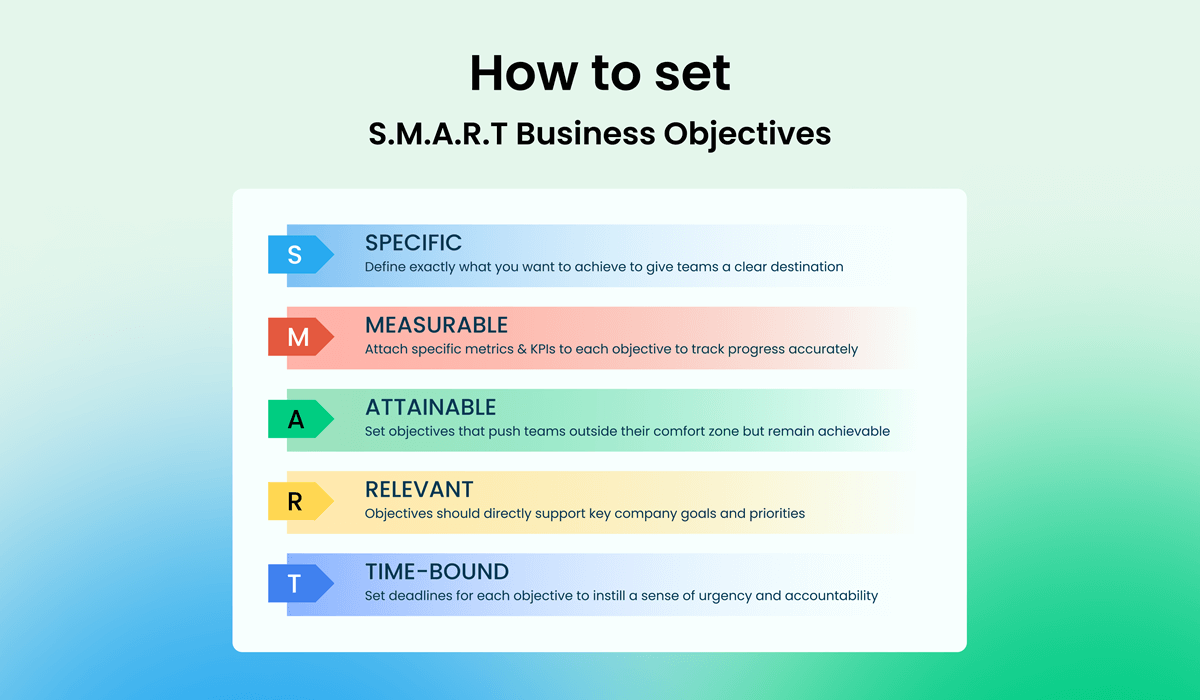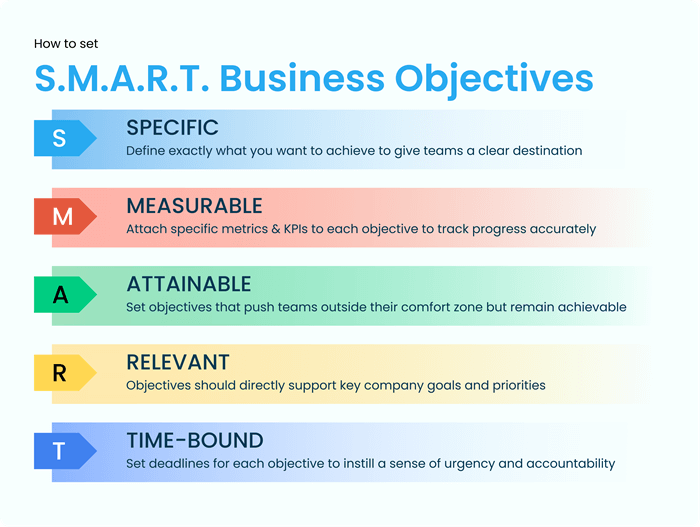6 steps to write a SMART goal for your business

Are you struggling to set clear, actionable goals and not knowing where to start? The SMART model might be the answer to your problem. Applying this principle lets you set intelligent, measurable goals and quickly boost personal performance. In this article, we'll explore the SMART model and implementation guidelines.
What are SMART goals?
George T. Doran, a management consultant, first introduced the term SMART in a research paper published in the Management Review journal in November 1981.
SMART is a group of criteria for setting goals - the acronym stands for:
- S – Specific: Clearly defined and specific.
- M – Measurable: Can be quantified or measured.
- A – Achievable: Attainable and realistic.
- R – Relevant: Relevant to the larger objectives.
- T – Time-bound: Has a clear deadline.

Benefits of the SMART goal-setting model
The SMART model is favored because it’s easy to remember, simple to use, and effective in setting goals. This model is widely used in both professional and personal settings.
SMART helps you define your goals clearly, avoiding ambiguity when reviewing or communicating them to your team. This clarity helps shape a complete picture of your objectives, enabling you to use appropriate resources and eliminate irrelevant ones.
Applying the SMART model accelerates strategic planning and enhances accuracy for businesses and managers, giving teams clear direction to align with common goals. Additionally, having specific, measurable goals boosts motivation, as individuals can see their progress and achievements. A well-defined framework for tracking and assessing effectiveness further strengthens this motivation.
When applied properly, the SMART model becomes a powerful tool for measuring and evaluating employee performance during team or specialized work.
“The establishment of objectives and the development of their respective action plans are the most critical steps in a company’s management process.”
- George T. Doran
5 elements of SMART
Specific
When using the SMART model, your goal should be specific, not broad. You're not trying to achieve success in every initiative but rather ensuring the success of a particular project. The goal must be specific, with a clear scope and description, to ensure all stakeholders understand it.
For example, instead of setting a goal to "write more blog posts," you could aim to "write 12 blog posts this month." This is much more specific and provides a clear roadmap for action.
Measurable
The "M" in SMART helps you evaluate whether your project is successful. Your goal needs to be quantifiable, meaning there should be an objective way to measure it—whether it’s a deadline, a number, or a percentage change. This allows you to determine the level of goal completion and motivates you to take action.
Including a specific number in your SMART goal is essential, typically a target you aim to reach. You can use benchmarks to set realistic and measurable goals.
Achievable
You don’t want your goal to be easily attainable, but it should be achievable within certain constraints—meaning it’s not entirely out of reach. An attainable goal is set within the scope of your capabilities, with available resources, and considering any external constraints.
For instance, if you aim to learn Japanese to greet a VIP client next month, it’s unrealistic to become fluent in just one month if you have no prior language knowledge. You might adjust your goal to mastering 50 essential Japanese business phrases instead.
Relevant
A goal is relevant when it aligns with or contributes to the organization’s broader objectives. This ensures that all efforts are directed towards a common purpose, making the goal meaningful within the larger business context. It also helps you and your team focus on the most critical activities that will deliver the most value.
Time-bound
Your SMART goal must have a time frame, as projects without deadlines can drag on, resulting in unclear success metrics and unnecessary scope expansion. A deadline also motivates you to start, monitor progress, and achieve the goal within a specified time.
The completion date is crucial because it’s the point at which all actions should be finalized for assessing success.
SMART vs. OKR - What’s the difference?
OKR (Objectives and Key Results) is a management framework that helps disseminate company strategy to employees, increasing transparency, focus, and alignment between personal and organizational goals. The OKR model was first developed by Andrew Grove of Intel and later popularized by Google.
An OKR model consists of one objective and multiple key results.
- Objective: Represents the goal, answering the question, "Where do we want to go?"
- Should be clearly defined and inspirational.
- Does not include specific numbers.
- Example: "Enhance the company’s digital culture."
- Key Results: Measure progress toward the objective, answering the question, "How do we know we are getting there?"
- Defined based on measurable progress.
- Example: "90% of employees use the new team management tool daily."
While both the SMART and OKR models stem from Peter Drucker’s Management by Objectives (MBO) approach, which believes that goals are key to organizational success, they have fundamental differences.
SMART provides a set of principles for setting specific goals, while OKR defines the system of objectives and their interrelationships. OKR not only addresses the question "What should the goal be?" but also considers "How do we achieve it?". In essence, SMART is more like a checklist, while OKR is a framework.
How to write SMART goals
In this section, we’ll break down how to set SMART goals following each criterion and illustrate how to refine goals from "not SMART enough" to completion.
Step 1: Write down your initial goal
Start by writing down your initial goal, which might be a general expectation or a broadly assigned objective. Don’t worry if it’s not SMART enough yet, as it will be refined in the following steps.
Example: "Reach more customers."
Step 2: Make it specific
Does the goal clearly define what you want to achieve? If not, refine it to make it more specific.
Example: "Reach more customers in the SEA region".
This goal specifies a target market (the SEA region) but lacks measurement, rationale, and a timeframe.
Step 3: Make it measurable
Have you established a precise measurement for the goal? If not, add a transparent and appropriate metric to evaluate success.
Example: "Reach 1,000 customers in SEA region".
This goal includes a specific target number for measuring success.
Step 4: Make it achievable
Is the goal realistic given the current and any additional resources that may be needed? At this step, you may need to tweak the goal to ensure it’s achievable.
After reviewing, the company finds that reaching 10,000 customers is unrealistic. Leadership redefines the goal to something more achievable: "Reach 100 customers in the SEA region".
This goal is challenging yet achievable.
Step 5: Align it to larger goals
If this goal is achieved, how does it contribute to the organizational goals in the next period? If not, will the company's objectives be affected?
Example: "Reach 100 customers in SEA to establish market presence".
This goal connects with the company’s broader objective of "establishing market presence." However, there is still no specific deadline.
Step 6: Set a time frame
When will you start and complete the execution and achievement of your goal? Clearly define the date or timeframe in your SMART goal.
A complete SMART goal might look like this: "In 6 months, reach 100 customers in the SEA region to establish market presence".
Common pitfalls when setting SMART goals
While the SMART model is generally considered simple, easy to remember, and accessible, its implementation can present challenges that prevent it from reaching its full potential. Key challenges include:
- Lack of understanding: To overcome this, managers should ensure that all employees, especially those directly involved in achieving the goals, are well-trained and understand the model. Training sessions and instructional materials will be essential.
- Setting irrelevant goals: This is common in business operations because not all employees know the broader organizational context. Senior managers can help by providing feedback on SMART goals and ensuring they meet the other four criteria before acceptance.
- Lack of monitoring and evaluation: The SMART model requires continuous monitoring and assessment to ensure progress toward specific goals. Establishing a tracking system and standardized reporting process will help adjust goals as needed.
The go-to framework for goal-setting
Despite the growing complexity of goal-setting strategies, SMART remains a go-to framework—trusted by individuals and organizations of all sizes. Its straightforward criteria provide a reliable rule of thumb for defining clear, measurable, and achievable goals, making it an enduring choice for anyone looking to drive meaningful progress, whether in a small team or a large enterprise.
FAQ Section

Tara Minh
Operation Enthusiast
On this page
- What are SMART goals?
- Benefits of the SMART goal-setting model
- 5 elements of SMART
- Specific
- Measurable
- Achievable
- Relevant
- Time-bound
- SMART vs. OKR - What’s the difference?
- How to write SMART goals
- Step 1: Write down your initial goal
- Step 2: Make it specific
- Step 3: Make it measurable
- Step 4: Make it achievable
- Step 5: Align it to larger goals
- Step 6: Set a time frame
- Common pitfalls when setting SMART goals
- The go-to framework for goal-setting
- FAQ Section